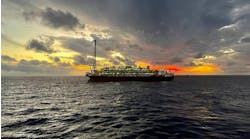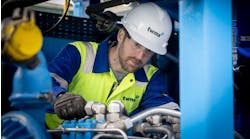David Paganie • Houston
Blind Faith flows first oil
Chevron flowed first oil from its Blind Faith field on Nov. 11. Daily production is expected to ramp up to approximately 65,000 bbl of oil and 55 MMcf of natural gas over the next three months.
Blind Faith is being developed with subsea wells tied back to a deep-draft semisubmersible production facility. The hull is moored in Green Canyon block 650 about 160 mi (250 km) southeast of New Orleans. Water depth in the field ranges from 6,500 to 7,000 ft (1,981 to 2,134 m).
The Blind Faith discovery well was drilled in June 2001 and encountered more than 200 ft (61 m) of net pay in Miocene sands at depths of 20,900 to 24,300 ft (6,370 to 7,407 m). A successful appraisal well was drilled in 2004. The field has an estimated gross resource potential of more than 100 MMboe.
Chevron operates Blind Faith with a 75% working interest. Anadarko holds the remaining 25%.
Marathon sanctions Droshky, Ozona
Marathon’s board of directors has approved $1.3 billion for development of the Droshky field and $300 million for development of the Ozona field. The company expects to initially book proved reserves of approximately 29 MMboe for Droshky and Ozona combined.
The Droshky discovery is in approximately 2,900 ft (884 m) of water in Green Canyon block 244 about 18 mi (29 km) southeast of Shell’s Bullwinkle platform. The project will consist of four development wells tied back to Bullwinkle. Noble’s semisumbersible rigNoble Paul Romano is scheduled to drill on the field in 2009, with first production targeted for 2010. Expected net peak production is about 45,000 b/d of oil and 43 MMcf/d of natural gas.
The initial Droshky discovery well and two sidetracks were drilled in 2007 to 21,190 ft (6,459 m) TD followed by a second delineation and sidetrack in 2008. Marathon holds a 100% working interest in Droshky.
The Ozona discovery is in approximately 3,000 ft (914 m) of water in Garden Banks block 515 about 6 mi (9.7 km) from Shell’sAuger TLP. Noble’s semisubmersible rig Noble Jim Day is scheduled to complete one previously drilled appraisal well, which will be tied back to the TLP. First production is expected in 2011, with an anticipated net peak rate of about 6,000 b/d of oil and 13 MMcf/d of natural gas. Marathon holds a 68% working interest in Ozona.
Ecopetrol, BP to target deep gas
Ecopetrol SA has agreed with two US subsidiaries of BP to drill for natural gas at depths exceeding 20,000 ft (6,096 m) in the GoM.
During the first year, the venture will drill at least one exploratory well. The companies also plan to acquire 3D seismic data. The conditions and development of subsequent stages will depend on the results obtained in the first stage, according to Ecopetrol. The company estimates investment for this first phase at approximately $120 million and says it will be carried out in two exploration areas in the Gulf.
Ecopetrol also has signed an agreement with Eni to farm in to the company’s GoM exploration portfolio. Ecopetrol will be assigned a 20-25% working interest in at least five wells to be drilled before Dec. 31, 2012. Under the terms of the agreement, Ecopetrol will invest and carry a portion of Eni’s drilling costs for a total in excess of $220 million.
Pony FEED goes to INTECSEA
Hess Corp. has awarded INTECSEA a contract for the subsea system and TLP hull and mooring FEED for the Hess-operated Pony project in Green Canyon blocks 468 and 469 in 3,200 to 3,800 ft (975 to 1,158 m) water depth. The work began in mid-September and is expected to be completed in 1Q 2009.
The subsea scope calls for the design of all subsea systems including trees, jumpers, flowlines, umbilicals, risers, subsea control systems, and other subsea structures.
The TLP hull and mooring scope includes hull sizing and global performance, design of the hull structure, hull systems, and the tendon moorings and foundations. The company also will carry out procurement support including development of procurement packages for long-lead components, and construction support.
ThePony TLP is being designed with a conventional four-column hull to support subsea trees. The field will be developed with seven production wells, three water injection wells, and a possible step out of 22 mi (35 km) to Ness.
In other TLP news, BHP says theShenzi TLP has been installed, the subsea wells are being hooked up, and topsides commissioning is under way. Two of five wells have been completed so far ahead of first production expected by mid-2009.
Caesar/Tonga development continues
Development work on the Caeasar/Tonga complex continues, with first production expected in the first half of 2011, according to Anadarko.
The company recently confirmed the West Tonga discovery with an appraisal well encountering high-quality subsalt Miocene sands with more than 700 ft (213 m) of net pay in dipping formations, the company says.
The discovery is part of a large continuous reservoir included in a 20,880-acre unit formed for development with the Caesar discovery, located 3 mi (5 km) to the north. West Tonga is in Green Canyon block 726 and Caesar is in Green Canyon block 683.
Procurement of long-lead items and FEED work is under way. Preliminary testing on the high-pressure riser that will enable development of the field as a subsea tieback to Anadarko-operatedConstitution spar is expected to be completed by year-end.
Meanwhile, Nexen is working with Shell on plans to continue exploring the western edge of DeSoto Canyon near the border of Mississippi Canyon. The company says it expects to drill a well in the area next year and to begin a feasibility study into development options for the Vicksburg discovery in DC 353. Shell’s nearby Shiloh discovery in DC 269 could be included in a joint development.
McMoRan to test ultra deep well
McMoRan plans to complete and test the South Timbalier block 168 No. 1 ultra deep exploratory well (formerly known as Blackbeard West No. 1). The well was drilled to 32,997 ft (10,057 m) TD in October and logs indicated four potential hydrocarbon-bearing zones below 30,067 ft (9,164 m) that require further evaluation, McMoRan says.
The well will be abandoned temporarily while completion equipment is secured for high-pressure testing. McMoRan says it will continue to review additional drilling opportunities on the flanks of the structure and on other acreage it holds in the immediate trend. The ST 168 well is on the top of the targeted structure. Seismic data on the prospect indicates the potential for significantly thicker sands on the flanks of the structure as confirmed in recent major deepwater discoveries, the company says. Based on information obtained to date in the ST 168 well, the company believes additional drilling on the flanks could result in significant reserve potential. Should this be the case, Rowan believes demand for ultra deep capacity jackups could increase by 5-10 rigs, reports Raymond James.
McMoRan operates the well on ST 168, which is the deepest well drilled below the mud line in the Gulf of Mexico, the company says. The well is permitted to 35,000 ft (10,668 m).
PGS begins deepwater 3D survey
PGS is expected to begin acquiring a new multi-client 3D seismic survey in the DeSoto Canyon area this month.
Covering approximately 250 deepwater blocks, the new program “Discovery” focuses on an area recently opened for leasing in the Central and Eastern GoM planning areas.
PGS plans to begin a 250-block multi-client 3D seismic survey in DeSoto Canyon this month.
PGS will be acquiring the 5,828-sq km (2,249-sq mi) survey using its new GeoStreamer technology. This will be the industry’s first 3D implementation of GeoStreamer yielding higher fidelity data, says PGS.
“It combines two different sensors yielding enhanced resolution and better penetration as well as improved efficiency due to deeper tow,” says Magne Reiersgard, PGS president of the North and South America region.
ThePGS Atlantic Explorer was scheduled to begin the first phase of data acquisition this month. The entire 250-block acquisition project will be completed in approximately nine months, the company says.
BP America Inc. will be an underwriter for the survey and technical collaborator on the project. PGS says the data will be available for the Gulf of Mexico lease sale in March 2010.
Woodside selects Paradigm G&G software
Woodside Energy has selected Paradigm’s next-generation geology and geophysics software for interpretation and velocity modeling in the Gulf.
Paradigm says it has advanced workflows in processing, interpretation, and analysis of large geographic regions where complex salt structures exist.
The company’s scope of delivery includes products for seismic processing, velocity analysis, stratigraphic delineation, structural interpretation, formation evaluation, and reservoir modeling.
Murphy orders subsea equipment
Murphy Exploration has awarded Aker Solutions a $23 million contract to supply subsea trees, control systems, and steel tube umbilicals for the company’s GoM development program.
The initial order includes two well sets and an umbilical. Delivery of all components is scheduled for 2Q 2009.
Engineering design and project management will be done at Aker’s office in Houston, Texas, with manufacturing of most components at the company’s subsea manufacturing center in Kuala Lumpur, Malaysia. Umbilicals will be manufactured in Mobile, Alabama, and offshore installation support will be provided from the company’s service base in Houston.
Neptune Marine Services secures work
Neptune Marine Services and its wholly owned subsidiary, US Underwater Services LP, have been awarded two NEPSYS repair projects in the Gulf worth $10 million.
The combined scope of work comprises a repair to an oil platform jacket leg and repair of a column-to-mat connection on a cantilever mat rig.
On the jacket leg, three X braces will be removed. Replacement braces will be wet welded on the scalloped sleeves before three NEPSYS welds are directly applied to the high strength steel at the nodes. Project duration is expected to be 60 days of 24-hour operations with a team of 10 welder/divers, 12 construction/inspection divers and tenders, two dive supervisors, and one project superintendent.
A smaller team of approximately 10 will undertake the work on the column-to-mat connection repair that is expected to take approximately 10-14 days to complete.
NEPSYS is the Neptune-patented dry underwater welding system that delivers a permanent weld equal to dry weld standards, according to Neptune.
Frontier Drilling’s semisubmersible rigFrontier Driller was christened at Signal International’s East Bank shipyard in Pascagoula, Mississippi on Nov. 1.
The event concluded a major upgrade of the rig, which first arrived at the yard in February 2006.
Signal renewed the rig’s electrical and mechanical systems, performed structural enhancements, refurbished the quarters, repainted the rig top to bottom, and installed new mooring and drilling equipment.
Shell plans to use the rig in the deepwater Gulf of Mexico.





